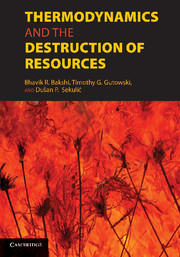Book contents
- Frontmatter
- Contents
- Contributor List
- Foreword by Herman E. Daly
- Foreword by Jan Szargut
- Preface
- Introduction
- PART I FOUNDATIONS
- PART II PRODUCTS AND PROCESSES
- PART III LIFE-CYCLE ASSESSMENTS AND METRICS
- 9 Using Thermodynamics and Statistics to Improve the Quality of Life-Cycle Inventory Data
- 10 Developing Sustainable Technology: Metrics From Thermodynamics
- 11 Entropy Production and Resource Consumption in Life-Cycle Assessments
- 12 Exergy and Material Flow in Industrial and Ecological Systems
- 13 Synthesis of Material Flow Analysis and Input–Output Analysis
- PART IV ECONOMIC SYSTEMS, SOCIAL SYSTEMS, INDUSTRIAL SYSTEMS, AND ECOSYSTEMS
- Appendix: Standard Chemical Exergy
- Index
- References
10 - Developing Sustainable Technology: Metrics From Thermodynamics
Published online by Cambridge University Press: 01 June 2011
- Frontmatter
- Contents
- Contributor List
- Foreword by Herman E. Daly
- Foreword by Jan Szargut
- Preface
- Introduction
- PART I FOUNDATIONS
- PART II PRODUCTS AND PROCESSES
- PART III LIFE-CYCLE ASSESSMENTS AND METRICS
- 9 Using Thermodynamics and Statistics to Improve the Quality of Life-Cycle Inventory Data
- 10 Developing Sustainable Technology: Metrics From Thermodynamics
- 11 Entropy Production and Resource Consumption in Life-Cycle Assessments
- 12 Exergy and Material Flow in Industrial and Ecological Systems
- 13 Synthesis of Material Flow Analysis and Input–Output Analysis
- PART IV ECONOMIC SYSTEMS, SOCIAL SYSTEMS, INDUSTRIAL SYSTEMS, AND ECOSYSTEMS
- Appendix: Standard Chemical Exergy
- Index
- References
Summary
Introduction
Several definitions for sustainability have been proposed, one of which is widely accepted. This definition was formulated by the Brundtland Commission in 1987, stating that sustainable development is a development that fulfills the needs of present generations without compromising the possibilities of fulfillment of the needs of future generations [1].
Technology is essential in sustainable development because it provides the products to fulfill the needs of the society. However, for delivering these products, the technosphere has to extract resources from the ecosphere, thereby diminishing the pool of resources available for next generations. Furthermore, emissions from the technosphere and from society are sent back to the ecosphere, causing several environmental problems such as acidification and global warming [2]. For these reasons, it is important that sustainable technologies be developed, resulting in a neverending delivery of products to society and involving less impact on the environment.
Stating that new technologies are more sustainable has to be argued by metrics [3–6]. Such metrics are sought by academics (e.g., Oldenburg University, Delft University of Technology, and Ghent University [4, 5, 7] as well as by industry (e.g., GlaxoSmithKline [8], Janssen Pharmaceutica [9], and Shell [10]). Although sustainability metrics should cover the economic, social, and environmental concerns of sustainability, matching the “Triple Bottom Line” of Elkington [11], only the environmental concern is discussed here.
- Type
- Chapter
- Information
- Thermodynamics and the Destruction of Resources , pp. 249 - 264Publisher: Cambridge University PressPrint publication year: 2011
References
- 2
- Cited by



